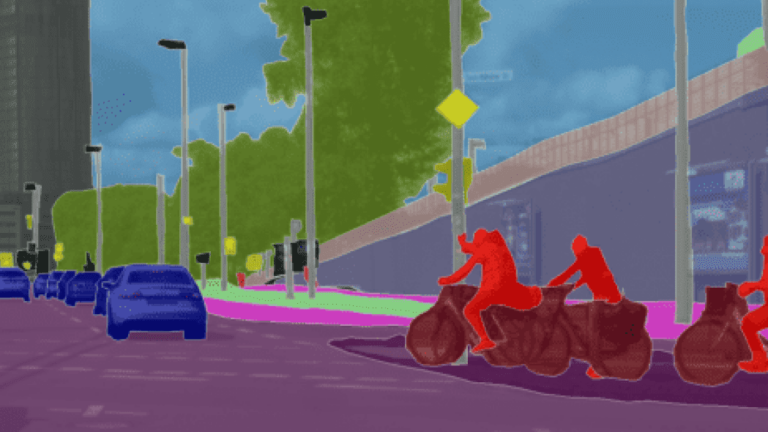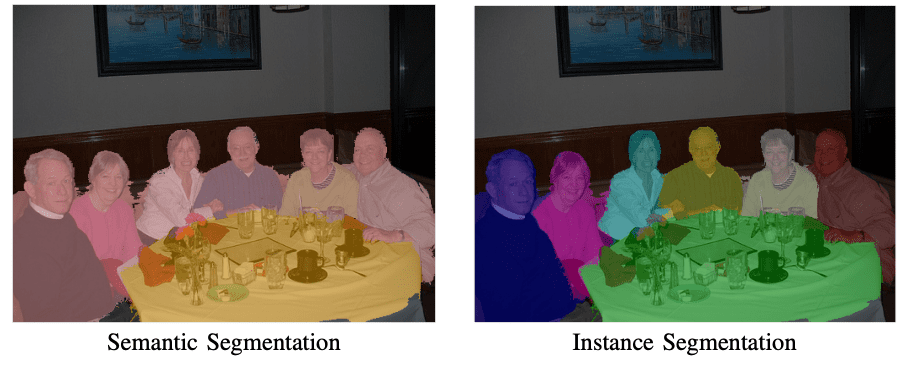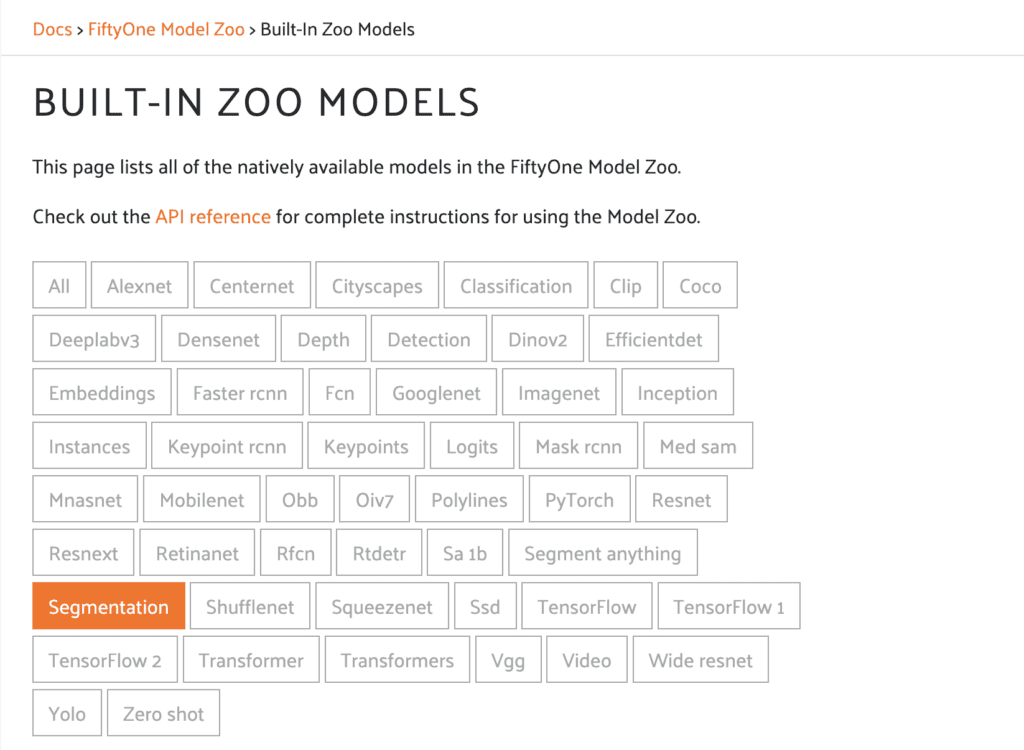A Guide to AI Image Segmentation

Image segmentation is a widely used technique in Computer Vision (CV) that divides an image into more meaningful and distinguishable objects. Image segmentation is commonly used in object detection, recognition, and tracking. It finds relevance in a variety of use cases such as healthcare for medical imaging, automotive, robotics, and many others.
In this guide, we’ll go through the basics of image segmentation, its benefits and techniques as well as explore effective workflows that you can easily implement in your CV work.
Understanding Image Segmentation
What Is Image Segmentation?
Image segmentation involves assigning a specific label to each pixel in an image, resulting in a label map where every pixel corresponds to a predicted category. This classification is referred to as pixel-level classification.
Semantic image segmentation is a specific type of image segmentation where each pixel is assigned a semantic class label, identifying what the pixel represents without differentiating between individual objects of the same class.
Instance segmentation is another type of image segmentation that differentiates between individual instances of the same object.
Consider an image example containing multiple cars. In semantic segmentation, all image pixels belonging to the car category would be labeled as a “car”. On the other hand, instance segmentation would label an individual car object with a unique label.
The accuracy of image segmentation models is highly dependent on the quality of image data. Poor image quality, diverse anatomical structures, and noise present major challenges when preparing data for image segmentation models. Specialized tools like FiftyOne can help development teams develop high-performing models backed by high-quality datasets. We’ll discuss more on that topic as well as outline workflows using FiftyOne that you can implement in a bit, so read on.
Benefits and Use Cases of Image Segmentation
Image segmentation is useful in extracting detailed information about objects, shapes, and boundaries. Analyzing shapes is useful in imaging, while boundary identification helps identify edges in images. For example, in use cases such as robotics, surveillance, or self-driving cars, the object-tracking capabilities of image segmentation help follow objects of interest over a given period.
Let’s explore this further across different use cases.
Scene understanding: Image segmentation helps to categorize different regions of an image so AI systems can understand complex scenes and be more accurate in tasks such as image captioning and scene classification.
Content manipulation: In tasks such as photo editing, image segmentation enables the enhancement of specific parts of an image without affecting the rest of the image. The most common use case we see is in augmented reality applications to overlay virtual objects onto real-world scenes.
Autonomous vehicles: In automotive use cases such as self-driving features, image segmentation enables vehicles to identify lanes, pedestrians, obstacles, and traffic signs for safe navigation.
Robotics and automation: Image segmentation enables robots to perform highly specialized tasks at high precision. For example, they can interact with objects and navigate effectively while avoiding obstacles.
Medical Imaging: Image segmentation is useful in isolating and analyzing anatomical structures and tumors to aid medical professionals in the diagnosis of disease.
Traditional image segmentation methods, such as thresholding, edge detection, and region-based algorithms, use specified parameters and heuristics. While they are useful for specialized tasks, they have limited adaptability and may not perform well across different or complicated images.
Modern segmentation algorithms, particularly those that use deep learning, provide greater versatility and customization. These methods can be customized for a variety of applications by training models on specific datasets, allowing them to understand complicated patterns and features specific to each task. For example, in photo editing, better segmentation models may reliably extract complicated objects or regions, allowing for more precise and creative modifications. By fine-tuning models on smaller, task-specific datasets, practitioners can improve accuracy and efficiency.
Overall, image segmentation is beneficial because:
- It is faster and more accurate than traditional methods such as region-based segmentation, edge detection, and clustering algorithms.
- It is scalable and adaptable to various domains.
Semantic Segmentation
In semantic segmentation, each pixel is assigned a class label, and all objects of the same type are given the same label. Let’s take a look at the image above that contains multiple people. With semantic segmentation, every pixel corresponding to a person is labeled identically, distinguishing them from the background and other objects as shown.
This approach offers several advantages:
- Enhanced Image Understanding: By categorizing each pixel, semantic segmentation provides a comprehensive understanding of the scene’s content, facilitating tasks like object recognition and scene interpretation.
- Improved Object Localization: Assigning consistent labels to objects of the same class allows for precise localization within the image, which is crucial for applications such as autonomous driving and robotic navigation.
- Simplified Data Analysis: Uniform labeling of similar objects streamlines the analysis process, making it easier to quantify and assess specific elements within an image.
By applying the same label to all objects of a particular class, semantic segmentation enables machines to process and interpret visual information more effectively.
Instance Segmentation
Instance segmentation, on the other hand, assigns a unique mask to each object instance within an image, even when multiple objects belong to the same class. This approach offers several advantages:
- Precise Object Differentiation: By generating distinct masks for each object, instance segmentation enables the identification and differentiation of individual instances, which is crucial in scenarios where understanding the exact number and location of objects is essential.
- Accurate Object Counting: The ability to distinguish between instances allows for the precise counting of objects, which is beneficial in applications like crowd analysis, inventory management, and even wildlife monitoring.
- Enhanced Object Tracking: In dynamic environments, such as video surveillance or autonomous driving, unique masks facilitate the tracking of specific objects over time, improving the system’s ability to monitor movements and interactions.
Instance segmentation provides detailed information about each object instance, enhancing the machine’s understanding of complex scenes and leading to more informed decision-making across various applications.
Image Segmentation with FiftyOne
FiftyOne is a tool that enables CV ML development teams to build high-performing models by getting a deeper understanding of the data, exploring and visualizing it, and analyzing model strengths and weaknesses down to the data sample level.
FiftyOne supports popular image segmentation techniques and makes it possible to visualize semantic and instance segmentation outputs through a powerful graphical interface.
FiftyOne enhances the visualization and interpretation of image segmentation datasets and models and offers comprehensive features tailored for image segmentation workflows:
- Dataset Visualization: FiftyOne allows users to examine datasets interactively by presenting images alongside their segmentation masks, so you can get a clear understanding of image segmentation and the discovery of patterns or discrepancies in the data.
- Model Evaluation: With FiftyOne, you can evaluate segmentation model performance using metrics like Intersection Over Union (IoU). Users can compare predicted masks to ground truth annotations to see where the model thrives and where it needs to be improved.
- Error Analysis: FiftyOne helps identify specific failure modes by identifying disparities between expected and actual segmentations. This targeted study is critical for refining models and improving segmentation accuracy.
- Data Curation: FiftyOne helps to curate datasets by detecting duplicate or mislabeled images, resulting in a high-quality dataset that contributes to better segmentation models.
Integration with Segmentation Libraries
One of the features that sets FiftyOne apart from other tools is its built-in integration with popular image segmentation models and algorithms like YOLO, DINOv2, ResNet, and Meta AI’s SAM2.
Check out the natively available models supported in FiftyOne and available in FiftyOne Model Zoo. Click on “segmentation” to filter the Model Zoo listings. You can use these models or bring your own.
Data Augmentation
One of the main challenges of training image segmentation models is the lack of enough data. This can lead to the model overfitting on the little data that is available. Augmenting the data using FiftyOne can help to alleviate this problem.
Augmenting image datasets enhances the generalization and robustness of segmentation models by exposing them to a diverse range of variations during the model training process. This process helps models perform effectively on new, unseen data. FiftyOne facilitates this by integrating with the Albumentations library, which offers a wide array of image augmentation techniques. Check out this tutorial on how to augment datasets in FiftyOne with Albumentations.
By applying transformations such as rotations, blurring, and noise addition, models learn to recognize objects under different conditions. This exposure reduces overfitting to the original dataset and improves the model’s ability to handle real-world variations.
Version Control and Experiment Tracking
With FiftyOne you can track different iterations of segmentation models along with their respective masks, giving full visibility into the development process. For example, FiftyOne has an integration with MLflow which enables you to track and register your segmentation models. It enables you to create stages for your model such as Staging, Production, and Archived.
Integration with Evaluation Metrics
FiftyOne simplifies the evaluation of segmentation models by providing tools to assess performance using metrics like Intersection over Union (IoU). IoU measures the overlap between predicted and ground truth segmentation masks, offering a pixel-level accuracy assessment. Beyond standard IoU, FiftyOne supports alternative evaluation strategies, such as focusing on boundary pixels, to provide a more nuanced understanding of model performance. These capabilities enable comprehensive analysis, helping to identify specific areas where a model excels or requires improvement.
Effective Segmentation Task Workflows with FiftyOne
Using Segmentation-Specific Integrations
FiftyOne supports integration with custom models and libraries tailored for specific segmentation tasks. For example, with the Segments AI integration, you can label 3D points cloud faster. The integration supports pointcloud-cuboid and pointcloud-vector.
Extracting Features to Improve Model Accuracy
Advanced ML techniques powered by FiftyOne Brain enable you to extract segmentation-specific features for better performance and model analysis. For example, you can visualize model embeddings to identify patterns and clusters in your dataset that can help improve the model’s accuracy.
Advanced techniques allow for identifying similar images and help analyze how the images affect performance. By examining clusters of similar images, you can detect groups where the model underperforms, indicating potential weaknesses in handling specific features or patterns. This facilitates the training of segmentation models with unique data through the computation of a uniqueness measure of an image with all the images in the dataset.
Leveraging Active Learning for Efficient Annotation
FiftyOne supports Active Learning, a strategy that makes data annotation faster by identifying the most informative or ambiguous examples for labeling. This is important because your segmentation model can improve even with less data. It’s made possible using FiftyOne’s Active Learning plugin, which you can integrate directly into your annotation workflow. Learn more about using this plugin on the Supercharge Your Annotation Workflow with Active Learning blog post.
Autonomous Vehicle Development
Another critical application of segmentation models is autonomous vehicle development. The use of FiftyOne in autonomous vehicles is quite similar to its applications in medical image segmentation with a few nuances. Like the previous application, FiftyOne can be used for data preparation, visualization, active learning, and model evaluation. You can use FiftyOne to review masks for pedestrians, vehicles, and road signs. You can use active learning to label difficult images to make the model more robust. FiftyOne integrates with popular libraries such as YOLO, TensorFlow, and PyTorch to enable the development of real-time applications.
Refining Existing Segmentation Models
FiftyOne allows you to refine models for object detection by improving segmentation mask accuracy through error analysis and correction. This can be done by overlying segmentation masks on images, making it faster to spot errors. You can perform error analysis to identify situations where predictions differ from the ground truth. FiftyOne supports the computation of segmentation accuracy metrics such as Intersection over Union (IoU). After computation, you can identify samples with low scores and focus on improving their score.
Furthermore, you can use FiftyOne’s Brain to analyze mistakenness and detect misclassifications and inconsistent masks. Once you have identified challenging samples, correct them manually or use FiftyOne’s Active Learning Feature. Finally, re-train the segmentation model using the new dataset.
Conclusion
Image segmentation has made it possible to detect the object, shape, and boundary of any object within images and video datasets. Semantic segmentation and instance segmentation have found great benefits in use cases ranging from robotics, and surveillance, to medical imaging and self-driving cars.
Next Steps
FiftyOne makes it easy to achieve accurate image segmentation. You can get started with FiftyOne in just a few minutes.
Looking for a scalable solution for your ML team as you collaborate on visual AI projects? Check out FiftyOne Teams and connect with an expert to see the collaborative, enterprise features of FiftyOne in action.




